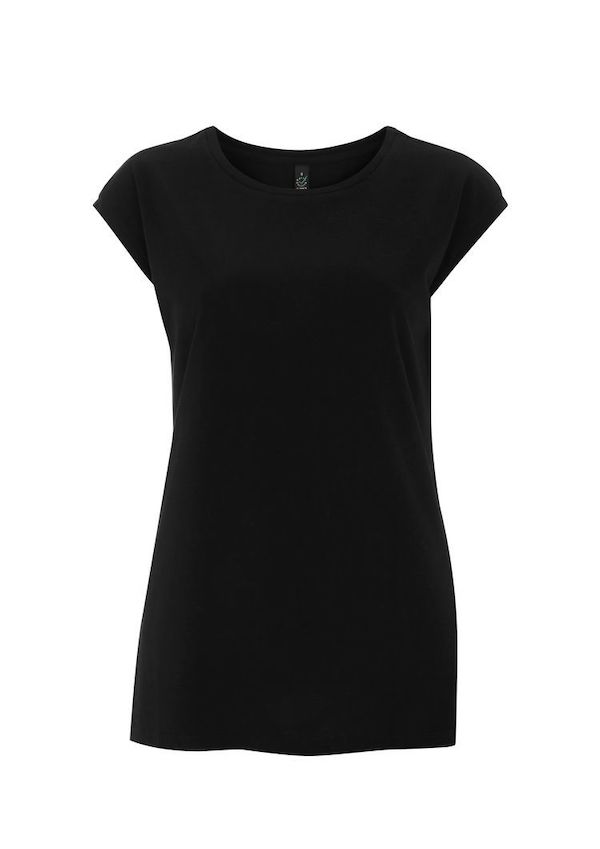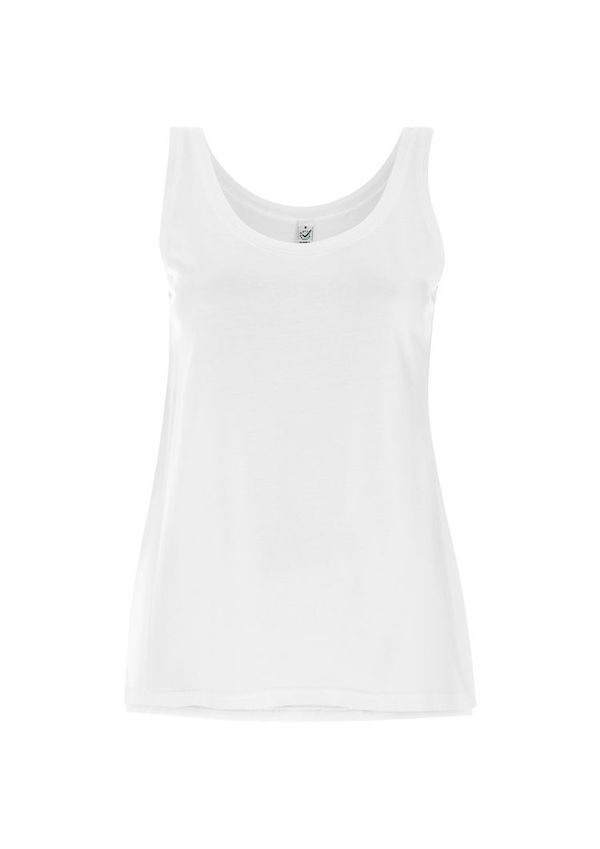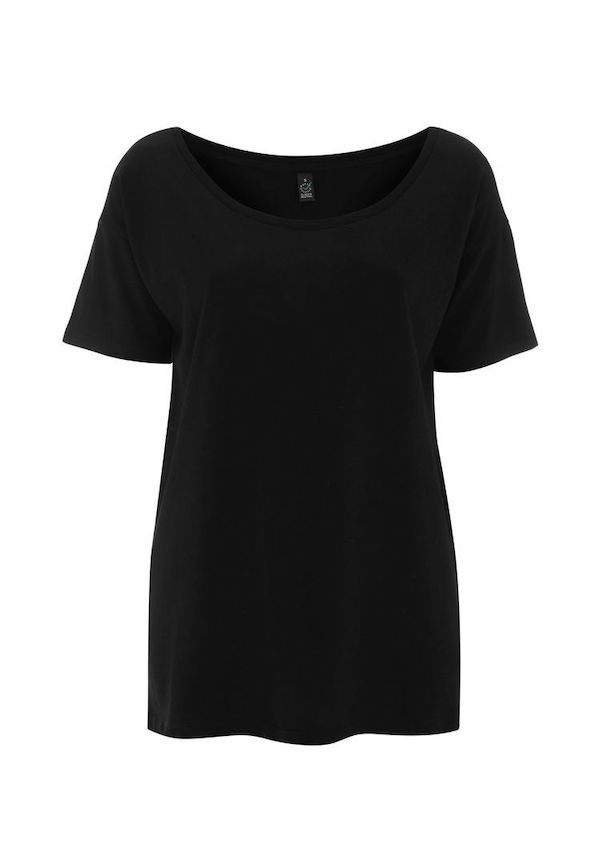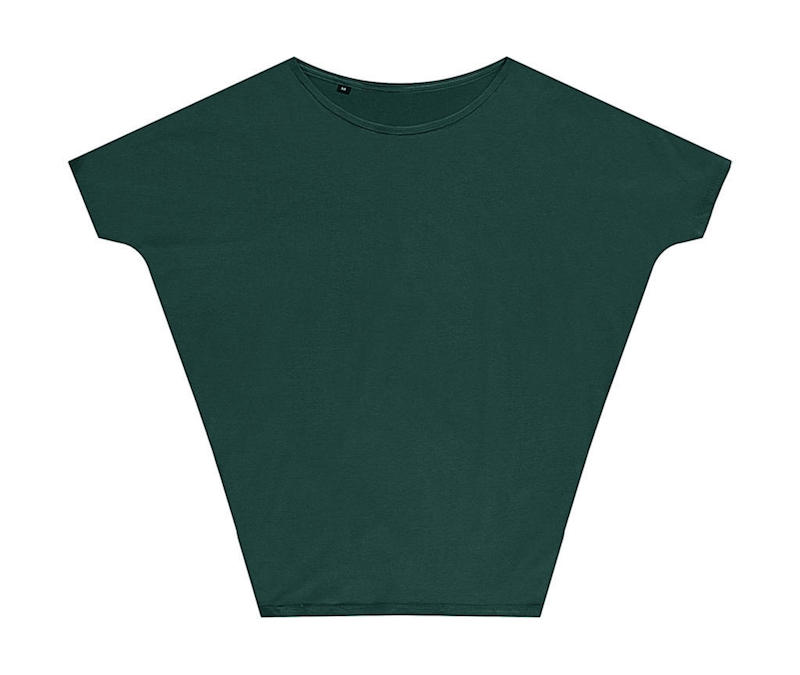Are you familiar with the textile manufacturing processes? Part 3: LYOCELL
In the third part of our series of articles about the origin of textile materials, we will look at Lyocell fibre. We can meet this modern natural material more and more often. Lyocell is ranked among the sustainable fibres of the new generation, mainly due to its more environmentally friendly production and ability to close the resource cycle. What raw materials does it come from and what does the process of its formation look like? Let's find out together!
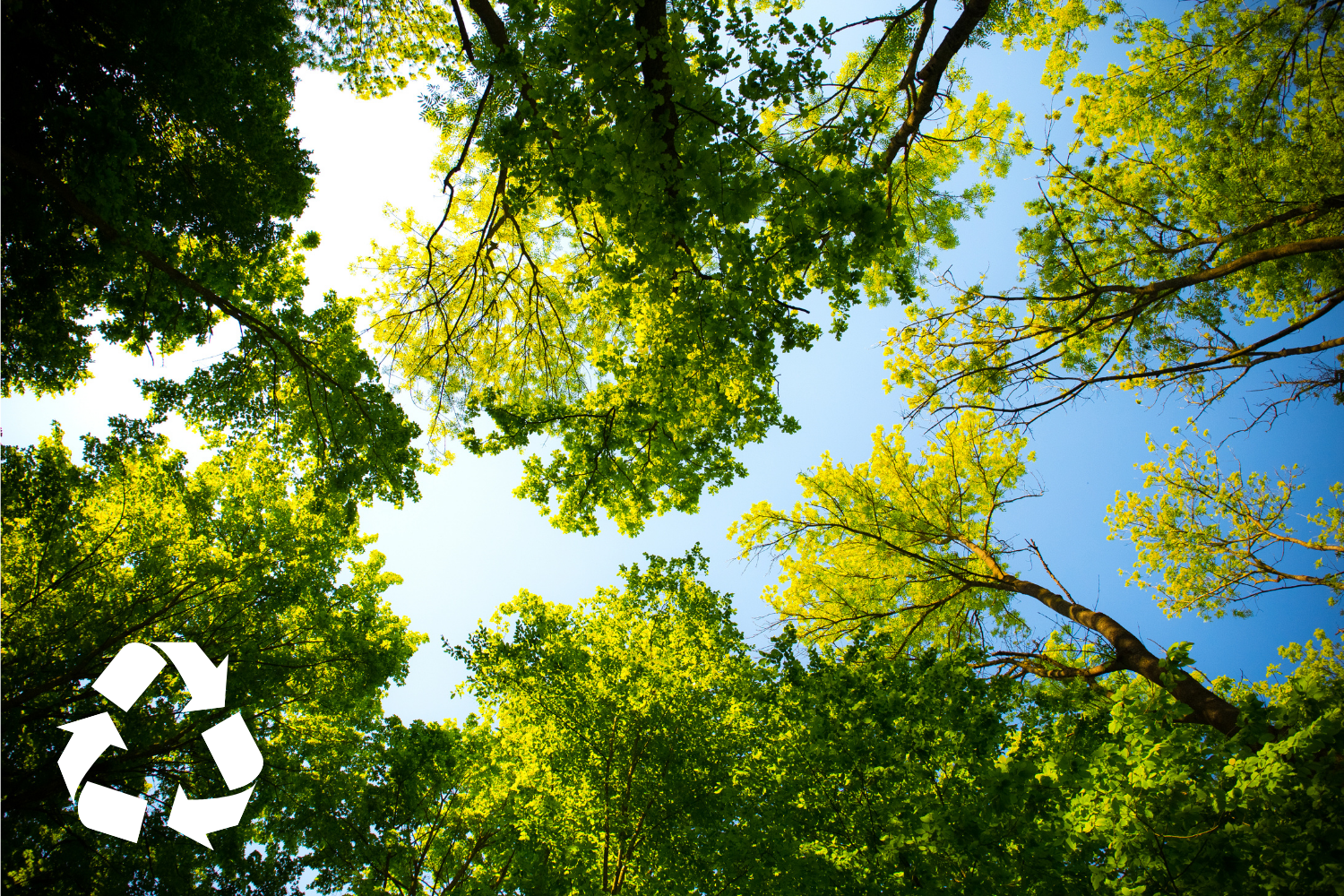
Lyocell is one of the semi-synthetic viscose fibres, which are formed on natural basis from cellulose. We can also find it under the abbreviation CLY. Lyocell was founded in the 1980s and was already manufactured industrially in the 1990s. It is a relatively new way of creating textile fibres, which is characterized by its environmental friendliness. It quickly became popular among the fashion industry and its popularity continued to rise. It has countless advantages, some of which surpass even classic cotton.
One of the best known and largest brands selling lyocell fibres is Lenzing's Tencel. This is one of the reasons why the name Tencel is sometimes used to refer to lyocell material. However, Tencel is simply a brand name, a trademark for a certain type of lyocell. Basically, both fabrics are made of cellulose wood fibres. However, Lyocell is made from bamboo pulp, while Tencel is made from other wood pulp, such as eucalyptus. Tencel is also more expensive than bamboo lyocell.
Lyocell fibres, especially Tencel, are often used in combination with other materials such as cotton, polyester and silk. The material thus acquires a smooth and shiny character, which is typical for lyocell.
What are the benefits of lyocell?
 Durability and processing options – Compared to cotton and viscose itself, lyocell is much more durable and stronger and it is also easier to maintain. Colours on the material last for a long time and, thanks to the nature of the fibre, they also stand out nicely. In addition, lyocell fibres can be well processed into various types of fabric - with a smooth surface up to a soft suede-like fabric.
Durability and processing options – Compared to cotton and viscose itself, lyocell is much more durable and stronger and it is also easier to maintain. Colours on the material last for a long time and, thanks to the nature of the fibre, they also stand out nicely. In addition, lyocell fibres can be well processed into various types of fabric - with a smooth surface up to a soft suede-like fabric.
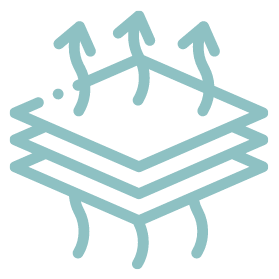 Pleasant texture – Lyocell is characterized by its smooth and soft surface, which is pleasant to touch. The fabric is light, airy and breathable, so it is a great choice for summer days. It is therefore often used for summer dresses and shirts.
Pleasant texture – Lyocell is characterized by its smooth and soft surface, which is pleasant to touch. The fabric is light, airy and breathable, so it is a great choice for summer days. It is therefore often used for summer dresses and shirts.
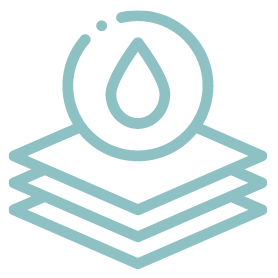 Moisture-wicking – It is suitable for hot summer days thanks to its great ability to absorb moisture, while leaving the skin feeling dry. Lyocell can even absorb up to half as much moisture as cotton (1). It is therefore often a popular choice for sportswear or bedding.
Moisture-wicking – It is suitable for hot summer days thanks to its great ability to absorb moisture, while leaving the skin feeling dry. Lyocell can even absorb up to half as much moisture as cotton (1). It is therefore often a popular choice for sportswear or bedding.
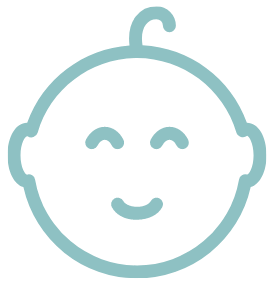 Suitability for sensitive skin – Lyocell is an ideal option for allergy sufferers and thanks to its antibacterial and thermoregulatory abilities, we do not sweat in it. However, it has to be said that it must not be degraded by toxic chemicals during processing.
Suitability for sensitive skin – Lyocell is an ideal option for allergy sufferers and thanks to its antibacterial and thermoregulatory abilities, we do not sweat in it. However, it has to be said that it must not be degraded by toxic chemicals during processing.
Care for nature and health 🌿
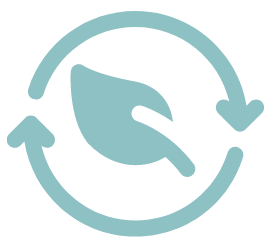 Sustainable resource cycle – Lyocell fibres use wood as a basic raw material, which is a renewable resource. The material is made on a natural basis and is therefore 100% biodegradable and compostable.
Sustainable resource cycle – Lyocell fibres use wood as a basic raw material, which is a renewable resource. The material is made on a natural basis and is therefore 100% biodegradable and compostable.
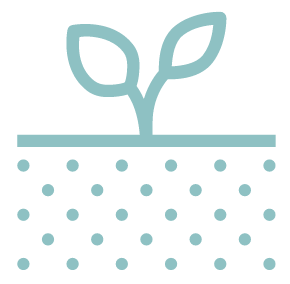 Low demands on cultivation – A significant advantage over conventional cotton is a much higher yield and harvest volume, as well as lower demands on quality of soil and its area. In addition, growing trees and plants does not need large amounts of moisture and pesticides.
Low demands on cultivation – A significant advantage over conventional cotton is a much higher yield and harvest volume, as well as lower demands on quality of soil and its area. In addition, growing trees and plants does not need large amounts of moisture and pesticides.
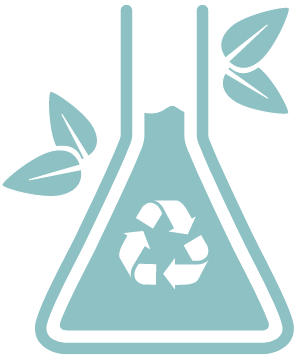 Environmentally friendly substances – No harmful by-products are produced during the production of lyocell, and no hazardous chemicals are used. The solvent used in production is non-toxic, recycled and over 99% is reused in the production process (2). It does not get to the environment and does not generate unnecessarily large amounts of waste.
Environmentally friendly substances – No harmful by-products are produced during the production of lyocell, and no hazardous chemicals are used. The solvent used in production is non-toxic, recycled and over 99% is reused in the production process (2). It does not get to the environment and does not generate unnecessarily large amounts of waste.
 Production efficiency – Looking at the whole production of lyocell fibres, half the water can be saved than is used in production of conventional cotton (3). Compared to production of other cellulose fibres, the production of lyocell is not only significantly less toxic but also more economical. The time of the production process is relatively short. It therefore consumes less water and energy compared to the production of other fibres.
Production efficiency – Looking at the whole production of lyocell fibres, half the water can be saved than is used in production of conventional cotton (3). Compared to production of other cellulose fibres, the production of lyocell is not only significantly less toxic but also more economical. The time of the production process is relatively short. It therefore consumes less water and energy compared to the production of other fibres.
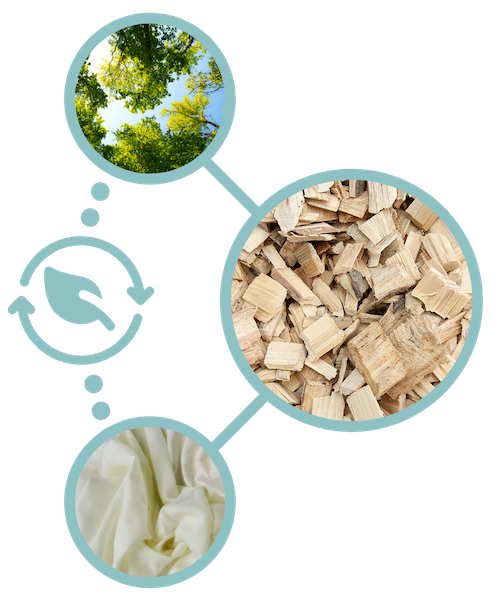
What are the disadvantages of lyocell?
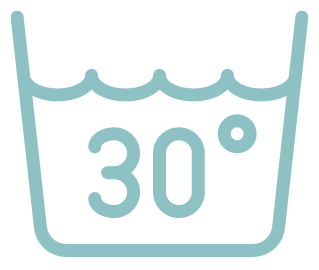 Washing and lint – Colder water is most suitable for washing lyocell. Textile with lyocell fibres is usually recommended to be washed with cold water, in contrast to polyester, which, on the other hand, can handle washing at higher temperatures. The lyocell material tends to release soft fibres during washing. This can manifest itself in form of lumps on the textile over a longer period of time.
Washing and lint – Colder water is most suitable for washing lyocell. Textile with lyocell fibres is usually recommended to be washed with cold water, in contrast to polyester, which, on the other hand, can handle washing at higher temperatures. The lyocell material tends to release soft fibres during washing. This can manifest itself in form of lumps on the textile over a longer period of time.
 Higher price – Compared to cotton, lyocell fabric tends to be more expensive for consumers. This is mainly due to more complex production technology, which requires more investment. However, lyocell fibre is generally more durable and does not need to be washed as often, which can reduce costs overall.
Higher price – Compared to cotton, lyocell fabric tends to be more expensive for consumers. This is mainly due to more complex production technology, which requires more investment. However, lyocell fibre is generally more durable and does not need to be washed as often, which can reduce costs overall.
 Beware of the processing method – As mentioned above, lyocell has several advantages - it is compostable, thermoregulatory, suitable for allergy sufferers, etc. However, it loses all these great abilities if it is dyed with synthetic dyes or otherwise ruthlessly chemically treated in subsequent stages of processing. Lyocell is also often mixed with other fibres, so we should not forget that, for example, in combination with polyester, the textile does not decompose naturally. Therefore, it is necessary to look at the overall composition of the product and especially to look at how the textile was made. Certifications and registered trademarks are helpful with this.
Beware of the processing method – As mentioned above, lyocell has several advantages - it is compostable, thermoregulatory, suitable for allergy sufferers, etc. However, it loses all these great abilities if it is dyed with synthetic dyes or otherwise ruthlessly chemically treated in subsequent stages of processing. Lyocell is also often mixed with other fibres, so we should not forget that, for example, in combination with polyester, the textile does not decompose naturally. Therefore, it is necessary to look at the overall composition of the product and especially to look at how the textile was made. Certifications and registered trademarks are helpful with this.
Sustainable certifications and brands
In order for lyocell to retain its unique properties, it must be manufactured and processed as considerately as possible. For lyocell, which is described as "organic", organic farming and tree-growing practices must be used. Toxic chemicals must also not be used at any stage of the production process. One of the auxiliary indicators for the choice of organic lyocell fibres can be the already mentioned Tencel brand, which strives for the most sustainable production.

Tencel textile fibres are certified to be degradable and compostable, and thus truly fulfil the lyocell's ability to return to nature and be a reusable resource. The wood comes from certified and responsibly managed forests exclusively. Tencel fibres have received the BioPreferred label from the USDA (US Department of Agriculture) and are certified by the internationally recognized EU Ecolabel, which can only be obtained by products that meet strict environmental criteria (3).
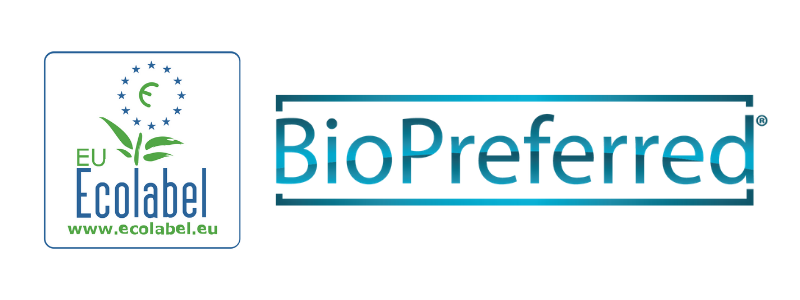
Let's choose textile responsibly and be friendly to natural resources and our health.
Lyocell production process
Lyocell is made of wood of various species of trees and plants, such as beech, oak, birch, spruce and eucalyptus, which is the most commonly used one. The production process of lyocell fibres goes through the following basic steps:
- Preparation of raw wood – Trees harvested from forests and farms are cleaned. And the bark is removed from the trunk.
- Chopping – The wood is chopped into small pieces or chips.
- Softening – Pieces of wood are softened into pulp, which is then washed with water and dried into slices or leaves.
- Dissolution – These slices are then broken up again into even smaller pieces. They are then placed in pressure and heating vessels with a solvent of concentrated amine oxide - organic compound N-methylmorpholine-N-oxide (NMMO) (4).
- Fiber production – The resulting solution with dissolved cellulose is filtered and passed through a spinning nozzle. This creates lyocell fibres, which then solidify.
- Washing, adjusting and drying – The solvent is then washed and cleaned of the fibres. More than 99% of the solvent is returned to production for reuse. Sometimes the fibres are also surface-treated and a lubricant such as soap, silicone, etc. is applied to them, which helps to unwind the strands of fibres and thus facilitate the process of spinning into yarns. The last step is drying, and the fibres are ready.
- Fabric formation – Furthermore, they can be wound on spools and spun into the form of fabric.
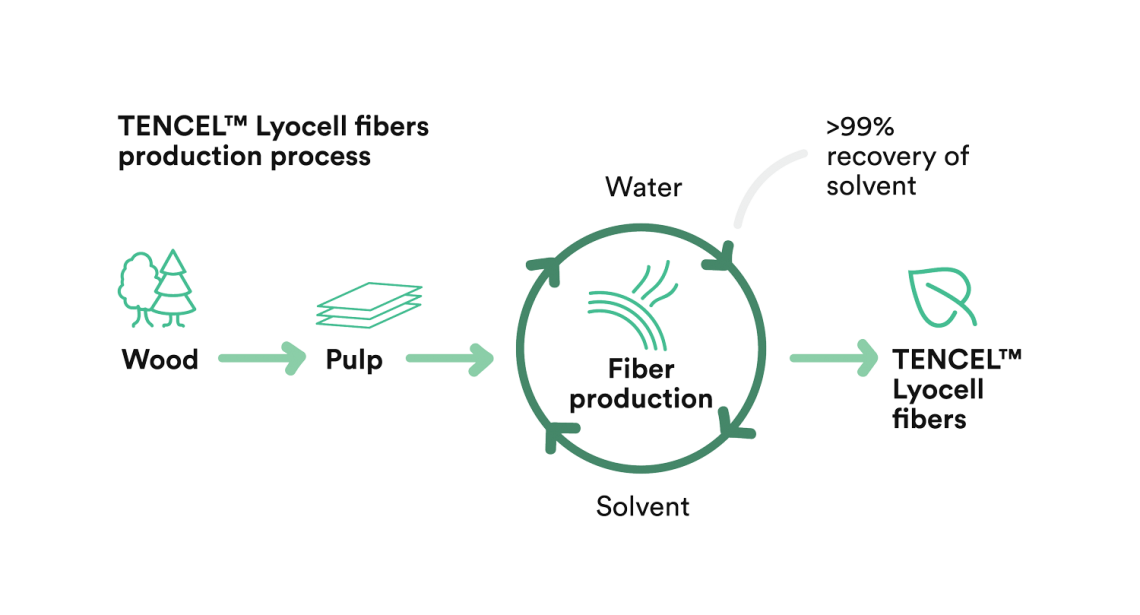
Source: lenzing.com
Suitable printing methods
Material from which the textile is made plays an important role in the choice of printing method. Following printing methods can be used for lyocell products:
- Screen printing – characterized by high quality, speed, accuracy and excellent colour fastness. It can be used on a wide range of materials.
- Hybrid printing – a combination of screen printing and digital printing, suitable for all types of textile, including polyester and various textile blends.
If you are not sure which type of printing to choose for a particular product, do not hesitate to send us a free inquiry form or write to us at info@merchyou.com and we will be happy to advise you.
Textil from certified lyocell in our offer
You can also find lyocell textile in our catalogue, for example, from Earth Positive, Russel Europe or Nakedshirt. All these brands offer sustainably produced lyocell Tencel.
50% organic cotton, 50% Tencel© Lyocell – Organic, Oeko-Tex
- Earth Positive Women's t-shirt (Black) – Fair Wear
- Earth Positive Women's tanktop (White) – Fair Wear
- Earth Positive Women's oversized T-shirt (Black) – Fair Wear
- Nakedshirt Chloé T-shirt (Stargazer)
Close alternatives to lyocell
Lyocell fibres have close relatives, which are also produced by Lenzing - viscose and modal. Basically, all these fibres are made of cellulose. However, they differ from each other by specific post-processing procedures. Modal has very similar properties to Tencel. It is soft, breathable and can absorb moisture perfectly. However, it is a little softer to the touch and is therefore often used on lighter and thinner fabrics, such as underwear. Like Tencel, Lenzing's Modal is certified as compostable.
Modal products from Stanley/Stella
50% organic cotton, 50% modal (Organic, Oeko-Tex, Fair Wear)
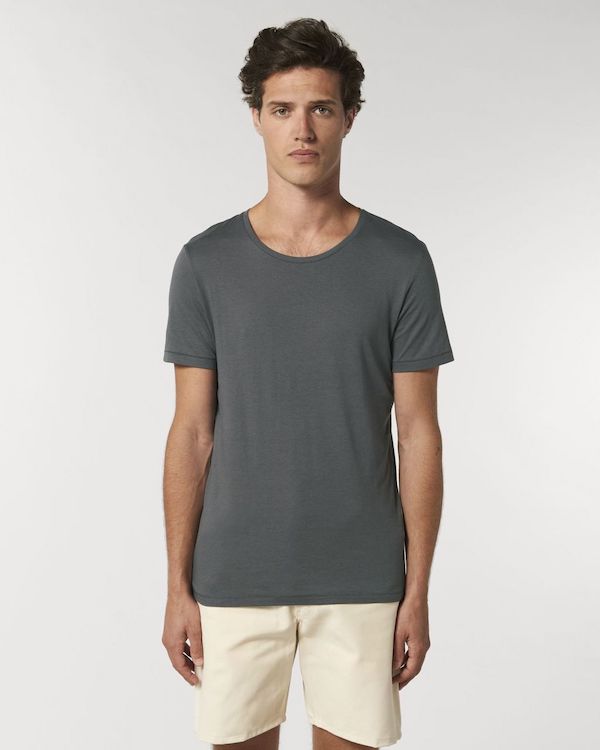
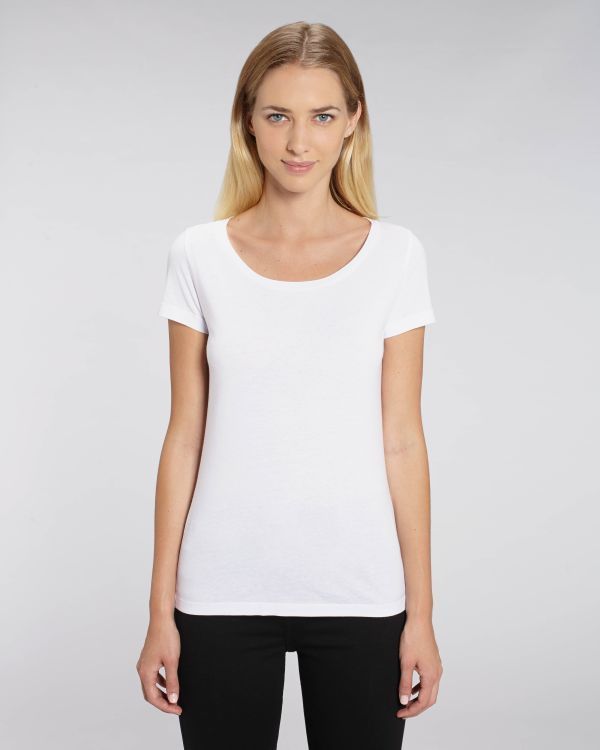
*Products are also available in other colours
Lyocell fibre really has many advantages. And thanks to its unique production technology and environmentally friendly processes, it is often called the thread of future. It is thus a revolutionary material for fashion industry and has the potential to become one of the top textile fibres used. Like certified organic cotton, lyocell is an example of how textile materials can be produced differently - with respect for nature and our health.
Let's be interested in the origin of the material and the final product we buy. By our choice, let’s support the kind of production that is resource-friendly, leaves a minimal ecological footprint and is in line with ethical and social standards. We only have one planet and one health. So let's choose responsibly! ♥
Odkazy
(1) The functional properties of Tencel
(2) Lenzing fibres production process
(3) The sustainability of Tencel
(4) Lyocell fiber

